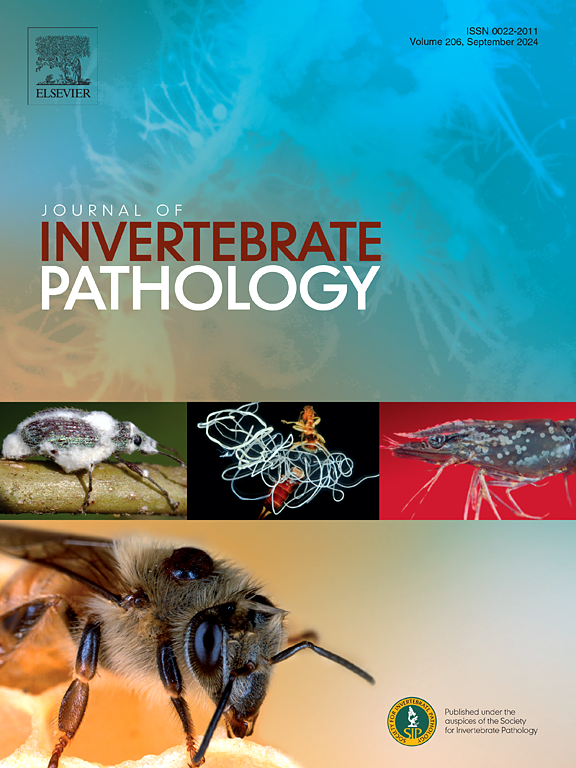光habduus杀线虫次生代谢物暴露后对虫病线虫适合度的影响。
IF 2.4
3区 生物学
Q1 ZOOLOGY
引用次数: 0
摘要
我们团队之前的研究表明,光habdus luminescens sonorensis的三种次生代谢物(SMs),反式肉桂酸(TCA), (4E)-5-苯基-4-戊烯酸(PPA)和吲哚,对根结线虫和柑橘线虫具有杀线虫和/或抑线虫活性,对非目标昆虫致病线虫(epn)没有明显的作用。为了进一步探讨epn的暴露后适应性,本研究重点研究了这些SMs对三种epn的毒力和生殖适应性的影响:sonorensis Heterorhabditis sonorensis (p.l. sonorensis的原生宿主)、H. bacteriophora和steinerma carpocapsae。结果表明,索诺氏弓形虫的毒力不受所测SMs的影响。TCA显着降低了嗜菌杆菌的毒力,降低了31% %,将死亡进展延迟到感染后8天,并将后代的出现延长了2天。然而,没有一种测试的SMs对嗜菌杆菌的后代产生不利影响。与此相反,这些菌株的毒力和繁殖适宜度均不受其影响。PPA对任何被测EPN物种的毒力和生殖适宜性没有不利影响。然而,TCA显示出一些效果,特别是对嗜菌杆菌。这些结果表明,PPA和吲哚可能是管理植物寄生线虫的更合适的选择,因为它对被测试的有益线虫物种没有负面影响。相比之下,由于所观察到的物种特异性效应,特别是在使用高浓度时,TCA可能需要谨慎,这强调了仔细考虑其应用浓度的必要性。本文章由计算机程序翻译,如有差异,请以英文原文为准。

Post-exposure effects of Photorhabdus nematicidal secondary metabolites on the fitness of entomopathogenic nematodes
Previous studies conducted by our team have shown that three secondary metabolites (SMs) from Photorhabdus luminescens sonorensis, trans-cinnamic acid (TCA), (4E)-5-phenyl-4-pentenoic acid (PPA), and indole, exhibit nematicidal and/or nematistatic activities against root knot and citrus nematodes, with no discernible effects on non-target entomopathogenic nematodes (EPNs). To further explore the post-exposure fitness of EPNs, this study focused on the effects of these SMs on the virulence and reproductive fitness of three EPNs: Heterorhabditis sonorensis (the native host of P. l. sonorensis), H. bacteriophora, and Steinernema carpocapsae. The results indicate that the virulence of H. sonorensis was not affected by the tested SMs. TCA significantly reduced virulence of H. bacteriophora, by 31 %, delayed mortality progression to eight days post-infection, and prolonged progeny emergence by two days. Nevertheless, none of the tested SMs adversely affected progeny production in H. bacteriophora. In contrast, the virulence and reproductive fitness of S. carpocapsae were not affected by any of the tested SMs. PPA did not adversely affect the virulence and reproductive fitness of any of the tested EPN species. However, TCA showed some effects, particularly for H. bacteriophora. These results suggest that PPA and indole may be a more suitable option for managing plant-parasitic nematodes among the tested SMs, as it showed no negative effects on the tested beneficial nematode species. In contrast, TCA may require caution due to the observed species-specific effects, particularly at the high concentration used, which underscores the need for careful consideration of its application concentration.
求助全文
通过发布文献求助,成功后即可免费获取论文全文。
去求助
来源期刊
CiteScore
6.10
自引率
5.90%
发文量
94
审稿时长
1 months
期刊介绍:
The Journal of Invertebrate Pathology presents original research articles and notes on the induction and pathogenesis of diseases of invertebrates, including the suppression of diseases in beneficial species, and the use of diseases in controlling undesirable species. In addition, the journal publishes the results of physiological, morphological, genetic, immunological and ecological studies as related to the etiologic agents of diseases of invertebrates.
The Journal of Invertebrate Pathology is the adopted journal of the Society for Invertebrate Pathology, and is available to SIP members at a special reduced price.

 求助内容:
求助内容: 应助结果提醒方式:
应助结果提醒方式:


